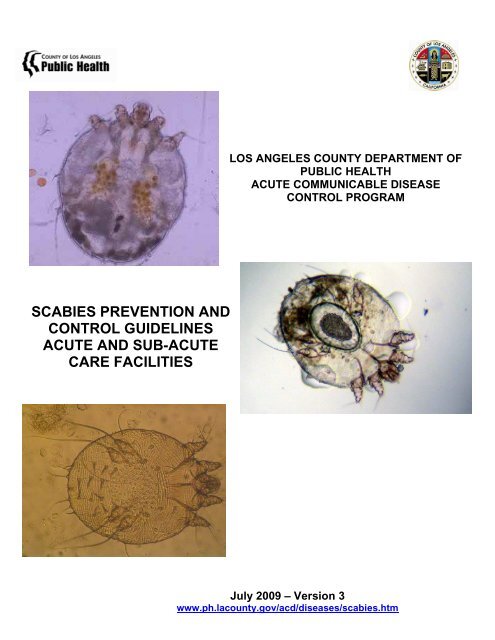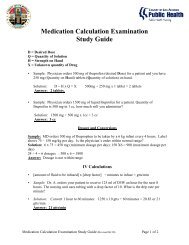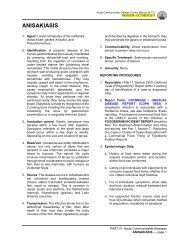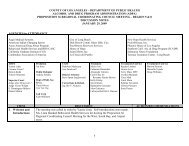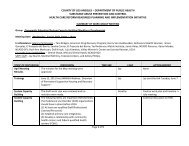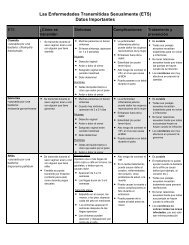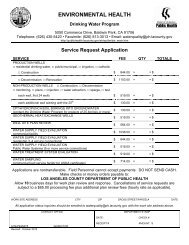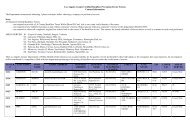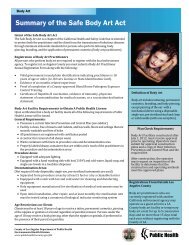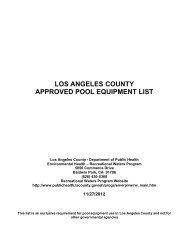Scabies Prevention and Control Guidelines Acute - Department of ...
Scabies Prevention and Control Guidelines Acute - Department of ...
Scabies Prevention and Control Guidelines Acute - Department of ...
Create successful ePaper yourself
Turn your PDF publications into a flip-book with our unique Google optimized e-Paper software.
SCABIES PREVENTION AND<br />
CONTROL GUIDELINES<br />
ACUTE AND SUB-ACUTE<br />
CARE FACILITIES<br />
LOS ANGELES COUNTY DEPARTMENT OF<br />
PUBLIC HEALTH<br />
ACUTE COMMUNICABLE DISEASE<br />
CONTROL PROGRAM<br />
July 2009 – Version 3<br />
www.ph.lacounty.gov/acd/diseases/scabies.htm
CONTENTS<br />
I. Introduction........................................................................................................... 3<br />
II. General Information............................................................................................ 3<br />
A. Biology <strong>of</strong> the <strong>Scabies</strong> Mite...................................................................... 3<br />
B. Clinical Presentation ................................................................................. 4<br />
1. Typical <strong>Scabies</strong> .............................................................................. 4<br />
2. Atypical <strong>Scabies</strong>.............................................................................. 5<br />
C. Epidemiology <strong>of</strong> <strong>Scabies</strong>............................................................................ 5<br />
1. Transmission................................................................................... 6<br />
2. Incubation Period ............................................................................ 6<br />
3. Period <strong>of</strong> Communicability .............................................................. 6<br />
D. Diagnosis ................................................................................................... 6<br />
III. <strong>Scabies</strong> <strong>Prevention</strong> <strong>and</strong> <strong>Control</strong> Programs........................................................... 6<br />
IV. <strong>Scabies</strong> Outbreak Management ........................................................................... 7<br />
A. Overview.................................................................................................... 7<br />
B. Summary <strong>of</strong> Action Steps .......................................................................... 8<br />
C. Management <strong>of</strong> Symptomatic Cases ......................................................... 9<br />
1. Symptomatic Health Care Workers ................................................. 9<br />
2. Symptomatic Patients ................................................................... 10<br />
D. Management <strong>of</strong> Contacts......................................................................... 10<br />
1. HCW Contacts .............................................................................. 11<br />
2. Patient Contacts............................................................................ 11<br />
E. Extending Recommendations for Prophylaxis ......................................... 12<br />
F. Notification <strong>of</strong> Staff, Visitors <strong>and</strong> Household Members ............................ 12<br />
V. Reporting............................................................................................................ 12<br />
VI. Appendices......................................................................................................... 13<br />
A. Diagnosis <strong>of</strong> <strong>Scabies</strong> by Skin Scraping ................................................... 14<br />
B. Treatment <strong>and</strong> Prophylaxis <strong>of</strong> <strong>Scabies</strong> .................................................... 16<br />
a) Application <strong>of</strong> Scabicides: General Principles ............................... 16<br />
b) Scabicides..................................................................................... 16<br />
c) Treatment Regimen: Typical <strong>Scabies</strong> Infection......................... 17<br />
d) Treatment Regimen: Crusted (Norwegian) or Atypical <strong>Scabies</strong> .... 18<br />
e) Treatment Failures ........................................................................ 19<br />
C. Treatment Options ................................................................................... 20<br />
D. Directions For <strong>Scabies</strong> Treatment or Prophylaxis With Elimite ................ 21<br />
E. <strong>Scabies</strong> Fact Sheet.................................................................................. 22<br />
F. Isolation <strong>and</strong> Environmental <strong>Control</strong> For Patients with <strong>Scabies</strong>............... 25<br />
G. <strong>Scabies</strong> Case/Contact Line-Listing Form: Employees ............................. 26<br />
H. <strong>Scabies</strong> Case/Contact Line-Listing Form: Patients.................................. 27<br />
I. Sample Letter to Discharged Patients ..................................................... 28<br />
J. Sample Letter to Physicians <strong>of</strong> Discharged Patients ............................... 29<br />
K. <strong>Scabies</strong> Outbreak Management Checklist ............................................... 30<br />
VII. References........................................................................................................ 31
I. INTRODUCTION<br />
<strong>Scabies</strong> is an ectoparasitic infestation <strong>of</strong> the skin caused by<br />
the human itch mite, Sarcoptes scabiei var. hominis. The<br />
actual incidence <strong>of</strong> scabies in Los Angeles County (LAC) is<br />
unknown because single occurrences <strong>of</strong> typical scabies are<br />
not reportable to the county health department. Outbreaks <strong>of</strong><br />
scabies infestations in health care facilities (HCF) <strong>and</strong> single<br />
cases <strong>of</strong> atypical scabies are reportable to the local health<br />
department <strong>and</strong> present a continuing public health problem in<br />
LAC. While regarded as a nuisance disease by many health<br />
care pr<strong>of</strong>essionals, scabies outbreaks in HCFs can be extremely costly in terms <strong>of</strong><br />
direct <strong>and</strong> indirect costs <strong>of</strong> outbreak management, poor public relations, <strong>and</strong><br />
discomfort <strong>and</strong> anxiety <strong>of</strong> affected patients, employees, <strong>and</strong> their family members.<br />
Furthermore, secondary bacterial skin infection is a common complication <strong>of</strong><br />
scabies infestation that, in elderly or immunocompromised individuals, can lead to<br />
sepsis <strong>and</strong> even death.<br />
A number <strong>of</strong> factors influence the extent <strong>of</strong> scabies transmission within a facility,<br />
including the mite load <strong>and</strong> the required level <strong>of</strong> care <strong>of</strong> the source case, as well as<br />
the duration <strong>of</strong> the exposure period. Each HCF scabies outbreak is unique <strong>and</strong><br />
requires an individualized approach. Due to the increase in the number <strong>of</strong><br />
outbreaks reported by HCF in LAC, these guidelines were developed to provide a<br />
rational approach to the prevention <strong>and</strong> control <strong>of</strong> scabies. They are intended to<br />
assist infection control committees <strong>and</strong> administrators <strong>of</strong> HCF in developing a<br />
scabies prevention <strong>and</strong> control program for their facility, <strong>and</strong> they are based on best<br />
practices, state <strong>and</strong> federal scabies guidelines, current literature <strong>and</strong> the extensive<br />
experience <strong>of</strong> <strong>Acute</strong> Communicable Disease <strong>Control</strong> Program (ACDC) staff.<br />
II. GENERAL INFORMATION<br />
A. BIOLOGY OF THE SCABIES MITE<br />
Infestation begins when one or several pregnant female mites are transferred<br />
from the skin <strong>of</strong> an infested person to the skin <strong>of</strong> an uninfested person. After<br />
transfer from the skin <strong>of</strong> an infested person, or, rarely, from fomites, to the skin <strong>of</strong><br />
an uninfested person, the adult female mite travels on the skin surface at the rate<br />
<strong>of</strong> about 1 inch per minute seeking a burrow site. After finding a suitable location,<br />
she burrows into superficial layers <strong>of</strong> the skin, forming a slightly elevated narrow<br />
tunnel where she deposits 2 to 3 eggs daily during her 4 to 6 week life span. The<br />
eggs progress through larval <strong>and</strong> nymphal stages to form adults in 10 to 17 days.<br />
The adults migrate to the skin surface <strong>and</strong> mate. The males die quickly <strong>and</strong> the<br />
females penetrate the skin <strong>and</strong> repeat the cycle. The mite requires human skin to<br />
complete its life cycle <strong>and</strong> is unable to survive <strong>of</strong>f the host at room temperature<br />
for more than 3 to 4 days.<br />
3
Life Cycle:<br />
From the CDC website: http://www.dpd.cdc.gov/dpdx/HTML/<strong>Scabies</strong>.htm<br />
B. CLINICAL PRESENTATION<br />
<strong>Scabies</strong> infestations are generally categorized as typical or atypical (crusted,<br />
keratotic or Norwegian).<br />
1. Typical <strong>Scabies</strong><br />
Patients with typical (conventional)<br />
scabies usually have only 10 to 15 live<br />
adult female mites on the body at any<br />
given time. Usually, only one or two<br />
mites, <strong>and</strong> frequently none, are<br />
recovered from skin scrapings.<br />
Intense pruritis, usually worse at night,<br />
<strong>and</strong> a papular rash with or without<br />
burrows occur. The rash <strong>and</strong> pruritis<br />
result from an immune-mediated<br />
delayed hypersensitivity reaction to the<br />
mite, its eggs, <strong>and</strong> fecal material.<br />
Areas <strong>of</strong> the body commonly involved are wrists, finger webs, antecubital fossae,<br />
anterior axillary folds, breasts, waistline, lower abdomen, genitals, <strong>and</strong> buttocks.<br />
The scalp <strong>and</strong> face are rarely involved in adults, but may be observed in young<br />
children with scabies.<br />
4
2. Atypical <strong>Scabies</strong><br />
When diagnosis <strong>and</strong><br />
treatment are delayed,<br />
scabies can have an<br />
unusual or atypical<br />
presentation, involving<br />
heavy infestation with<br />
hundreds to thous<strong>and</strong>s<br />
<strong>of</strong> mites. Atypical clinical<br />
presentations are more<br />
prevalent in<br />
institutionalized or<br />
debilitated patients, or<br />
those who are immunosuppressed from underlying disease or drug therapy.<br />
When extensive hyperkeratotic skin lesions with crusting <strong>and</strong> scaling develop,<br />
the infestation is called crusted scabies or hyperkeratotic (formerly<br />
“Norwegian”) scabies. Crusted scabies is highly contagious because<br />
thous<strong>and</strong>s <strong>of</strong> mites are imbedded in the thick crusts <strong>and</strong> easily shed in scales<br />
<strong>and</strong> flakes from affected skin. Crusted scabies is commonly misdiagnosed by<br />
dermatologists, <strong>and</strong> patients with crusted scabies may develop symptoms <strong>of</strong><br />
typical scabies in as little as a few days.<br />
C. EPIDEMIOLOGY OF SCABIES<br />
1. Transmission<br />
Transfer <strong>of</strong> the mite is usually from one person to another by direct skin-toskin<br />
contact. Procedures such as bathing a patient, applying body lotions,<br />
back rubs, or any extensive h<strong>and</strong>s-on contact can provide an opportunity for<br />
mite transmission. Mites may also be transmitted via clothing, bed linen or<br />
other fomites. Fomites play a minor role in situations where the infestation in<br />
the source case is typical scabies; the inanimate environment <strong>of</strong> patients with<br />
crusted scabies, however, has been shown to be heavily contaminated with<br />
infectious mature <strong>and</strong> immature mites. In HCF, scabies may be introduced<br />
into the facility by a newly admitted resident with an unrecognized infestation<br />
or by visitors or health care workers as a result <strong>of</strong> contact with an infested<br />
person in the home or community.<br />
2. Incubation Period<br />
In a previously unexposed healthy individual, the interval between exposure<br />
<strong>and</strong> the onset <strong>of</strong> itching is usually 4-6 weeks. In persons who have been<br />
sensitized to the mite by a previous infestation, re-exposure may produce<br />
5
D. DIAGNOSIS<br />
symptoms in 48 hours or less (owing to prior sensitization to the mite <strong>and</strong> its<br />
saliva <strong>and</strong> feces). Following exposure to a source case with crusted scabies<br />
involving extremely large numbers <strong>of</strong> mites, the incubation period may be<br />
reduced from the usual time <strong>of</strong> 4-6 weeks to as little as a few days.<br />
3. Period <strong>of</strong> Communicability<br />
Since the scabies mite is an ectoparasite, an exposed individual is<br />
potentially immediately infectious to others, even in the absence <strong>of</strong><br />
symptoms. Cases are communicable from the time <strong>of</strong> infestation until<br />
mites <strong>and</strong> eggs are destroyed by treatment.<br />
Definitive diagnosis requires microscopic identification <strong>of</strong> the mite <strong>and</strong>/or its eggs<br />
or fecal pellets on specimens collected by skin scraping, biopsy or other means<br />
(Appendix A, “Diagnosis <strong>of</strong> <strong>Scabies</strong> by Skin Scraping”). The yield from skin<br />
scrapings is highly dependent on the experience <strong>of</strong> the operator <strong>and</strong> the severity <strong>of</strong><br />
the infestation. A negative skin scraping from a person with typical scabies does<br />
not rule out scabies infestation; mites are easily recovered, however, in skin<br />
scrapings from persons with crusted scabies.<br />
III. SCABIES PREVENTION AND CONTROL PROGRAMS<br />
It is recommended that HCF incorporate a scabies prevention program that involves<br />
all levels <strong>of</strong> the health care team. The program should include an assessment <strong>of</strong><br />
the skin, hair <strong>and</strong> nail beds <strong>of</strong> all new admissions as soon as possible following<br />
arrival. Pruritus, rashes <strong>and</strong> skin lesions should be documented <strong>and</strong> brought to the<br />
attention <strong>of</strong> the nursing supervisor <strong>and</strong> the attending physician for further follow-up.<br />
Essential elements <strong>of</strong> a successful scabies prevention program include:<br />
1. Written policies <strong>and</strong> procedures for prevention <strong>and</strong> control <strong>of</strong> nosocomial<br />
scabies;<br />
2. Health care workers who are trained to be suspicious <strong>of</strong> scabies in themselves<br />
or their patients if unexplained rash or pruritus occurs in themselves or their<br />
patients, <strong>and</strong> to report such occurrences to their supervisors;<br />
3. A policy to screen newly admitted patients for scabies during the initial<br />
assessment (especially if transferred from another healthcare facility) <strong>and</strong> any<br />
suspect patient will immediately be placed on contact isolation until examined<br />
for scabies;<br />
4. A policy that all new employees (especially employees who work at more than<br />
one facility) will be screened for scabies as part <strong>of</strong> pre-employment screening;<br />
6
5. Access to <strong>and</strong> use as needed <strong>of</strong> the diagnostic skills <strong>of</strong> a consultant<br />
experienced in recognizing scabies to evaluate difficult or unusual cases or<br />
response to treatment;<br />
6. Assurance <strong>of</strong> adequate support from hospital administration, medical staff,<br />
infection control, employee health <strong>and</strong> line staff for appropriate evaluation <strong>and</strong><br />
treatment <strong>of</strong> employees, in-house patients <strong>and</strong> exposed discharged patients<br />
should an outbreak <strong>of</strong> nosocomial scabies occur.<br />
IV. SCABIES OUTBREAK MANAGEMENT<br />
A. OVERVIEW<br />
The primary goal <strong>of</strong> an outbreak investigation is to identify risk factors contributing to<br />
the outbreak <strong>and</strong> to take corrective action to prevent further transmission <strong>of</strong> scabies<br />
cases. In general, an outbreak can be defined as an increase in the incidence <strong>of</strong><br />
new cases above baseline within a defined period <strong>of</strong> time <strong>and</strong> within a defined<br />
geographical location (nursing unit, one floor or one wing, a department or, in some<br />
cases, the entire hospital).<br />
A “baseline” for scabies is not a st<strong>and</strong>ard hospital measurement <strong>and</strong> the definition <strong>of</strong><br />
a scabies outbreak may be multifaceted. A case definition should be developed to<br />
determine whether an outbreak has occurred or to estimate the magnitude <strong>of</strong> the<br />
outbreak. The following are examples <strong>of</strong> scabies hospital outbreak definitions:<br />
Two (2) or more confirmed (positive skin scraping) cases <strong>of</strong> scabies identified in<br />
patients, healthcare workers, volunteers <strong>and</strong>/or visitors during a two (2) week<br />
period <strong>of</strong> time, or<br />
One (1) confirmed (positive skin scraping) <strong>and</strong> at least two (2) clinically suspect<br />
cases identified in patients, healthcare workers, volunteers <strong>and</strong>/or visitors during<br />
a two (2) week period <strong>of</strong> time, or<br />
At least two (2) clinically suspect cases identified in patients, healthcare workers,<br />
volunteers <strong>and</strong>/or visitors during a two (2) week period <strong>of</strong> time.<br />
Nosocomial transmission is highly probable if scabies is confirmed in two or more<br />
health care workers who have worked in the same area <strong>of</strong> the facility within the<br />
previous six weeks <strong>and</strong> who do not have an apparent source <strong>of</strong> exposure outside<br />
the facility.<br />
Outbreak management should include planning for protective equipment <strong>and</strong><br />
pharmacy supplies. Provisions should be made for obtaining additional personal<br />
protective equipment (PPE) such as disposable, long sleeve gowns <strong>and</strong> gloves. The<br />
pharmacy should also make arrangements for obtaining permethrin (Elimite) 5%<br />
cream. If ivermectin (Stromectol) is recommended as a scabies treatment option the<br />
pharmaceutical company should be notified <strong>and</strong> arrangements made for overnight<br />
shipping if necessary.<br />
7
B. SUMMARY OF ACTION STEPS<br />
1. Immediately remove from work any health care worker with signs <strong>and</strong><br />
symptoms <strong>of</strong> scabies <strong>and</strong> refer to employee health or other designated<br />
consultant or clinician experienced in the diagnosis <strong>of</strong> scabies.<br />
2. Evaluate patients on affected units <strong>and</strong> immediately place patients with<br />
suspected scabies in contact isolation (Appendix F)<br />
3. Report nosocomial scabies outbreaks <strong>and</strong> single cases <strong>of</strong> crusted scabies<br />
infestation to LAC ACDC.<br />
4. Meet with key staff to coordinate control measures. Representatives from<br />
the following departments should be included: Administration, Employee<br />
Health, Environmental Services, Infection <strong>Control</strong>, Pharmacy, Medical Staff,<br />
<strong>and</strong> Nursing. One person, generally the Infection <strong>Prevention</strong>ist (formerly<br />
Infection <strong>Control</strong> Pr<strong>of</strong>essional), should coordinate control measures <strong>and</strong><br />
should be given adequate resources to accomplish this objective in a timely<br />
<strong>and</strong> efficient manner.<br />
5. Search for a possible source case. If two or more employees working in the<br />
same unit/area are diagnosed with scabies, it is likely that the source case<br />
was a patient with crusted scabies infestation.<br />
6. Confirm the presence <strong>of</strong> scabies by microscopic identification <strong>of</strong> the mite or<br />
its products (skin scraping) in one or more symptomatic patients or<br />
employees.<br />
7. Prepare a line listing <strong>of</strong> symptomatic patients <strong>and</strong> health care workers <strong>and</strong> a<br />
separate line listing <strong>of</strong> their contacts (Appendix G <strong>and</strong> H). Evaluate contacts<br />
for scabies.<br />
8. Treat symptomatic patients <strong>and</strong> health care workers with an approved<br />
scabicide, provide prophylactic scabicide to all contacts <strong>of</strong> symptomatic<br />
cases, <strong>and</strong> perform environmental cleaning <strong>of</strong> affected units. Ideally, these<br />
steps (treatment, prophylaxis, <strong>and</strong> environmental cleaning) should all be<br />
accomplished within the same 24 hour period to prevent re-infestation <strong>of</strong><br />
treated or prophylaxed individuals.<br />
9. Provide training to all staff on the signs <strong>and</strong> symptoms <strong>of</strong> scabies. Stress<br />
that people can be infested <strong>and</strong> contagious for up to 6 weeks before any<br />
symptoms start.<br />
10. Perform environmental cleaning <strong>of</strong> affected units (Appendix F).<br />
8
11. Arrange for follow-up evaluation <strong>and</strong> prophylactic treatment <strong>of</strong> discharged<br />
patients who were contacts to scabies. (Appendix I <strong>and</strong> J).<br />
C. MANAGEMENT OF SYMPTOMATIC CASES<br />
Often the first indications <strong>of</strong> a scabies outbreak are complaints <strong>of</strong> itching <strong>and</strong><br />
rash in two or more health care workers or patients/residents. Properly<br />
performed skin scrapings will almost always be positive in persons with crusted<br />
scabies but are generally negative in cases <strong>of</strong> typical scabies, even when<br />
performed by experienced operators. None-the-less, it is recommended that<br />
efforts be made to confirm the diagnosis <strong>of</strong> scabies (perform skin scraping) in at<br />
least one symptomatic individual.<br />
1. Symptomatic Health Care Workers<br />
Health care workers (HCW) refer to all facility employees, contract<br />
employees, medical staff, house staff, students, religious workers <strong>and</strong><br />
volunteers, etc.<br />
a. Immediately remove from work any HCW with signs or symptoms<br />
consistent with scabies <strong>and</strong> refer to employee health or other designated<br />
consultant experienced in the diagnosis <strong>of</strong> scabies. Confirm the<br />
presence <strong>of</strong> scabies by microscopic identification <strong>of</strong> the mite or its<br />
products in one or more symptomatic patient or employee (Appendix A).<br />
b. Prepare a line-listing <strong>of</strong> symptomatic HCWs that includes name, age,<br />
gender, symptoms, date <strong>of</strong> onset, result <strong>of</strong> scabies evaluation, any prior<br />
treatment for scabies, usual work <strong>and</strong> "float" assignments from six<br />
weeks before onset <strong>of</strong> symptoms until the current date, <strong>and</strong> symptoms in<br />
household or other close contacts (Appendix G).<br />
c. Treat all HCWs with confirmed or suspected scabies infestation with an<br />
approved scabicide according to consultant’s recommendation or as<br />
outlined in Appendix B. Review scabicide package insert before<br />
prescribing, dispensing, or applying scabicide. Provide clearly<br />
written instructions for proper application <strong>of</strong> dispensed scabicide<br />
(Appendix D). Re-evaluate cases weekly to monitor response to<br />
treatment.<br />
d. Symptomatic HCWs can return to work as soon as treatment is<br />
completed but should use gowns <strong>and</strong> gloves for direct patient care to<br />
prevent reinfestation until all control measures for affected units/areas<br />
have been completed.<br />
e. Provide scabicide prophylaxis, along with written instructions for<br />
application, for all household contacts <strong>of</strong> symptomatic HCWs.<br />
9
2. Symptomatic Patients<br />
a. Immediately place any patient in whom scabies infestation is suspected<br />
in contact isolation as outlined in the CDC “Guideline for Isolation<br />
Precautions in Hospitals” <strong>and</strong> Appendix F, “Isolation <strong>and</strong> Environmental<br />
<strong>Control</strong> for Patients with <strong>Scabies</strong>.” Maintain contact isolation until<br />
treatment is completed <strong>and</strong>/or case is determined by dermatology<br />
consultant or other experienced designee to be non-infectious.<br />
b. Attempt to confirm the diagnosis <strong>of</strong> scabies by microscopic identification<br />
<strong>of</strong> the mite, its eggs, or fecal pellets if the patient is the suspected source<br />
<strong>of</strong> the outbreak or if the clinical diagnosis <strong>of</strong> scabies is in question<br />
(Appendix A). If patient is a suspected case <strong>of</strong> crusted scabies, obtain<br />
dermatology consult for assistance with diagnosis <strong>and</strong> management.<br />
c. Treat with an approved scabicide according to consultant’s<br />
recommendation or as described in Appendix B.<br />
d. Perform environmental cleaning <strong>of</strong> case-patient’s room/ area as<br />
described in Appendix F.<br />
D. MANAGEMENT OF CONTACTS<br />
Contacts to typical (non-crusted) scabies cases are defined as persons who<br />
had “h<strong>and</strong>s-on” contact, h<strong>and</strong>led infested clothing or bed linen, or slept in the<br />
same bed as the case-patient during the exposure period.<br />
Contacts to atypical (crusted) scabies also include persons who had<br />
substantial contact with a crusted scabies case-patient’s environment, including<br />
HCWs who worked (regular or “float” assignment) on the same unit/area as the<br />
case-patient during the exposure period. If the case-patient was housed on<br />
more than one unit before control measures were initiated, each unit must be<br />
considered affected.<br />
The outbreak exposure period is the period between the admission date <strong>of</strong> a<br />
scabies case <strong>and</strong> the date the condition is correctly diagnosed <strong>and</strong> control<br />
measures are implemented. If the case-patient is a long-term care resident,<br />
this period extends from six weeks prior to onset <strong>of</strong> symptoms. The<br />
identification <strong>of</strong> two or more symptomatic HCWs assigned to a particular unit<br />
suggests that prophylaxis is indicated for all unit/area contacts, whether or not<br />
they were direct contacts <strong>of</strong> a known scabies case.<br />
Occasionally, a source case cannot be identified. In this situation, the exposure<br />
period should be considered to extend from 6 weeks before onset <strong>of</strong> symptoms<br />
(most <strong>of</strong>ten in HCWs) to the date <strong>of</strong> implementation <strong>of</strong> control measures.<br />
10
1. HCW Contacts<br />
a. Identify <strong>and</strong> prepare a line listing <strong>of</strong> all HCWs who were direct contacts<br />
to a patient or fellow employee with scabies during the exposure period<br />
(Appendix G).<br />
b. Interview HCW contacts to determine presence <strong>of</strong> scabies symptoms<br />
<strong>and</strong> possible source <strong>of</strong> exposure; manage as a case if symptomatic.<br />
c. Provide prophylactic scabicide along with written instructions for<br />
application, as described in Appendix B, to all HCW with direct contact to<br />
a scabies case. HCW scabies contacts who refuse prophylactic<br />
treatment must be required to wear gowns <strong>and</strong> gloves for contacts<br />
with patients or fellow employees for 6 weeks from the date <strong>of</strong> last<br />
potential exposure (usually 6 weeks from implementation <strong>of</strong> control<br />
measures).<br />
2. Patient Contacts<br />
a. Identify <strong>and</strong> prepare a line listing <strong>of</strong> all patients who were contacts to a<br />
patient with scabies or employee with scabies during the exposure<br />
period (Appendix H). This includes patients who resided on the same<br />
ward as a crusted scabies case during the exposure period <strong>and</strong> those<br />
who were already discharged.<br />
b. Examine in-house patient contacts to determine presence <strong>of</strong> signs <strong>and</strong><br />
symptoms <strong>of</strong> scabies. If symptomatic, manage as a case.<br />
c. Apply prophylactic scabicide, as described in Appendix B, to in-house<br />
patients with direct contact to a scabies case.<br />
d. Patients who resided on the same ward as a crusted scabies patient with<br />
no direct contact to the case should be monitored with daily skin<br />
observations until six weeks past the date <strong>of</strong> last potential exposure <strong>and</strong><br />
follow-up as appropriate.<br />
e. Notify discharged patient contacts <strong>of</strong> their potential exposure to<br />
scabies. Screen discharged patients for symptoms <strong>of</strong> scabies.<br />
Symptomatic patients should receive treatment <strong>and</strong> their family contacts<br />
should receive prophylaxis. Asymptomatic patients should be directed to<br />
follow up with their physician regarding possible scabies exposure <strong>and</strong> at<br />
a minimum, observe skin daily until six weeks past the date <strong>of</strong> last<br />
potential exposure. It is the responsibility <strong>of</strong> the facility to ensure<br />
that all discharged exposed patients receive appropriate follow-up<br />
11
(Appendices I <strong>and</strong> J, “Sample letters to discharged patients <strong>and</strong> their<br />
physicians”).<br />
f. Notify facilities to which patient contacts have been transferred <strong>of</strong> their<br />
potential exposure.<br />
E. EXTENDING RECOMMENDATIONS FOR PROPHYLAXIS<br />
Facility-wide (mass) prophylaxis <strong>of</strong> all patients <strong>and</strong> at-risk employees<br />
(employees involved in direct patient care or exposed to patient care<br />
environment) should be considered if positive scrapings are found in patients or<br />
employees assigned to 2 or more areas <strong>of</strong> the facility where no direct link with<br />
an infested case-patient or HCW can be established.<br />
F. NOTIFICATION OF STAFF, VISITORS AND HOUSEHOLD MEMBERS<br />
V. REPORTING<br />
Healthcare workers, volunteers, family members, sexual partners, <strong>and</strong> anyone<br />
else who have had contact with a scabies case should be notified immediately<br />
<strong>of</strong> the facility outbreak <strong>and</strong> assessed for symptoms. A scabies fact sheet <strong>and</strong><br />
notification letter, which includes information about the scope <strong>of</strong> the outbreak<br />
<strong>and</strong> strategies that are being implemented to control the outbreak <strong>and</strong> prevent<br />
future cases, should be distributed to the above groups.<br />
Single cases <strong>of</strong> atypical (crusted) scabies <strong>and</strong> all outbreaks <strong>of</strong> scabies are<br />
required to be reported to Los Angeles County <strong>Department</strong> <strong>of</strong> Public Health<br />
during normal business hours, Monday through Friday, 8:00 A.M. to 5:00<br />
P.M. <strong>Acute</strong> care facilities should report by phone to their ACDC Liaison Public<br />
Health Nurse or the Hospital Outreach Unit at (213) 240-7941. Long term care<br />
facilities <strong>and</strong> home health agencies should report to the Morbidity Unit at (888)<br />
397-3993. Outbreaks are also reportable to Los Angeles County <strong>Department</strong> <strong>of</strong><br />
Public Health, Health Facilities Division <strong>of</strong> Licensing <strong>and</strong> Certification.<br />
The <strong>Scabies</strong> <strong>Prevention</strong> <strong>and</strong> <strong>Control</strong> <strong>Guidelines</strong> <strong>Acute</strong> <strong>and</strong> Sub-<strong>Acute</strong> Care<br />
Facilities <strong>and</strong> additional scabies information <strong>and</strong> resources can be found at the<br />
ACDC website www.ph.lacounty.gov/acd/diseases/scabies.htm.<br />
12
APPENDICES<br />
13
APPENDIX A<br />
DIAGNOSIS OF SCABIES BY SKIN SCRAPING<br />
The diagnosis <strong>of</strong> scabies can be confirmed by microscopic identification <strong>of</strong> mites, eggs<br />
or scybala (fecal pellets) from specimens obtained by skin scrapings. A physician or<br />
nurse from the facility can be taught the procedure by a dermatologist, the consulting<br />
physician or by a nurse or technician who has had pr<strong>of</strong>essional training to perform the<br />
procedure. A confirmed diagnosis <strong>of</strong> scabies should be made in at least one<br />
symptomatic case before recommending wide-spread scabicide prophylaxis in health<br />
care facility outbreaks. A physician, nurse or other healthcare pr<strong>of</strong>essional who has<br />
been trained to perform the procedure should only do skin scrapings.<br />
Equipment<br />
1. Gloves <strong>and</strong> gowns 8. Mineral oil or immersion oil<br />
2. Magnifying glass 9. Slides <strong>and</strong> cover slips<br />
3. Light source such as goose neck lamp 10. Laboratory requisition forms<br />
4. Felt tip pen, green or blue washable ink 11. Sharps container<br />
5. Alcohol swabs/wipes 12. Clear nail polish<br />
6. #15 scalpel blade <strong>and</strong> h<strong>and</strong>le, 13. Microscope<br />
7. Glass slides or curettes for scraping<br />
Procedure<br />
Observe patient’s skin with a magnifying lens <strong>and</strong> look for lesions suggestive <strong>of</strong> scabies<br />
infestation. The shoulders, back, abdomen, h<strong>and</strong>s, wrists, elbows, buttocks, axillae,<br />
knees, thighs <strong>and</strong> breasts are<br />
common sites for burrows.<br />
1. Use h<strong>and</strong> magnifying lens to<br />
identify recent burrows or<br />
papules. A bright light <strong>and</strong><br />
magnifying lens will assist in<br />
visualizing the tiny dark<br />
speck (the mite) at the end<br />
<strong>of</strong> the burrow.<br />
2. Identify these high yield<br />
lesions by applying mineral<br />
oil (best used over dry scaly<br />
areas) or by applying the<br />
burrow ink test to possible burrows. The burrow ink test is done by using a wide<br />
felt tip pen (blue or green are best) over burrows <strong>and</strong> then wiping <strong>of</strong>f with an<br />
alcohol swab. The alcohol will remove most surface ink, but will not remove the<br />
ink taken up by the burrow, thus leaving a dark irregular line.<br />
14
3. Apply mineral oil or preferably microscope immersion oil to lesions or scalpel<br />
blade <strong>and</strong> glass slides.<br />
4. Scrape non-excoriated, non-inflamed areas (burrows <strong>and</strong> papules) vigorously<br />
with a #15 scalpel blade or glass slide held at a 90-degree angle to the skin,<br />
while holding the skin taut, until the stratum corneum is removed. (Vigorous<br />
scraping appropriately results in a few red blood cells visible under the<br />
microscope, but there should not be frank bleeding.) Some practitioners prefer<br />
using a small curette. Change blades or curettes between scrapings on different<br />
persons. Blades can be placed on <strong>and</strong> removed from the h<strong>and</strong>le with a forceps.<br />
Used blades must be placed in a sharps container.<br />
5. Transfer skin scrapings from at least 6 different sites to a single slide or to<br />
separate slides. These scrapings can be pushed onto the slide edge <strong>and</strong> then<br />
moved to the center <strong>of</strong> the slide.<br />
6. Place the cover slip over the slide.<br />
7. Examine entire slide methodically under low power (2.5-4x) <strong>and</strong> then at 25-50x<br />
magnification. Microscopic examination <strong>of</strong> the skin scrapings should be<br />
performed at the facility; however, if the practitioner is not trained in reading the<br />
prepared slides, the cover slip should be secured to the slide at all edges with<br />
clear nail polish <strong>and</strong> transported by courier, or by mail (in a secure mailer) to a<br />
hospital or laboratory or to a physician’s <strong>of</strong>fice with prior-arrangements.<br />
15
APPENDIX B<br />
TREATMENT AND PROPHYLAXIS OF SCABIES<br />
A. Application <strong>of</strong> Scabicides: General Principles<br />
1. Gowns <strong>and</strong> gloves are worn when applying scabicides to patients.<br />
2. Bathe patients as usual <strong>and</strong> change bed linens. Allow skin to cool completely.<br />
3. Apply scabicide to every square inch <strong>of</strong> skin, from the posterior ear folds down<br />
over the entire body. Include intergluteal cleft, umbilicus, skin folds, palms <strong>and</strong><br />
soles, <strong>and</strong> webs between fingers <strong>and</strong> toes. If scabicide is washed <strong>of</strong>f during<br />
h<strong>and</strong>washing, toileting, or perineal care, it must be reapplied.<br />
4. In infants <strong>and</strong> young toddlers, the elderly, <strong>and</strong> the immunocompromised, the<br />
head (forehead, temples, <strong>and</strong> scalp) requires application <strong>of</strong> scabicide. Pay close<br />
attention to the area behind the ears. Do not get the scabicide near the eyes or<br />
mouth. Prior treatment failure may be an indication to include the head upon<br />
retreatment.<br />
5. Fingernails <strong>and</strong> toenails should be clipped <strong>and</strong> scabicide applied under nails.<br />
6. Follow directions <strong>and</strong> precautions outlined in the package insert accompanying<br />
scabicide.<br />
7. A cleansing bath is taken when scabicide is to be removed.<br />
8. Linens <strong>and</strong> clothing are changed after treatment. Contaminated clothing <strong>and</strong><br />
linens may be 1) dry-cleaned or 2) washed in the hot cycle <strong>of</strong> the washing<br />
machine <strong>and</strong> dried in the hot cycle <strong>of</strong> the dryer for 10-20 minutes.<br />
9. Provide detailed written instructions for scabicide use when dispensing scabicide<br />
for home application by employees <strong>and</strong> household members.<br />
B. Scabicides<br />
1. 5% permethrin cream (Elimite, Acticin) - currently considered drug <strong>of</strong> choice.<br />
a. The usual adult dose is 30 grams. A 60 gram tube should treat two adults.<br />
b. For adults <strong>and</strong> children, the cream should be massaged into the skin from<br />
below the chin to the soles <strong>of</strong> the feet. <strong>Scabies</strong> rarely infests the scalp <strong>of</strong><br />
adults, although the hairline, neck, temple, <strong>and</strong> forehead may be infested in<br />
16
infants <strong>and</strong> geriatric patients. Infants should be treated on the scalp, temple<br />
<strong>and</strong> forehead.<br />
c. The patient should be instructed to remove the medication by thoroughly<br />
bathing 8 to 14 hours after application. Contact with the eyes <strong>and</strong> mouth<br />
should be avoided. If contact with the eyes occurs, they should be<br />
immediately flushed with water.<br />
d. Permethrin is regarded as safe for children two months <strong>of</strong> age <strong>and</strong> older. No<br />
instance <strong>of</strong> toxicity following accidental ingestion has been reported. The<br />
most commonly reported side effects are pruritus, edema <strong>and</strong> erythema,<br />
which may continue for up to two weeks after treatment. Patients should be<br />
told that the itching or stinging <strong>of</strong> scabies infestation may continue after<br />
treatment, <strong>and</strong> repeated application <strong>of</strong> the scabicide should be avoided.<br />
Demonstrable living mites after 14 days indicate that retreatment is necessary.<br />
e. Although animal studies showed no adverse effects to reproductive function<br />
or damage to the fetus, no adequate studies have been done on pregnant<br />
women. Therefore, permethrin should be used during pregnancy only when<br />
clearly necessary. If treatment is necessary for lactating mothers, breastfeeding<br />
should be discontinued during the treatment period.<br />
2. 10% crotamiton cream or lotion (Eurax)<br />
a. Massage thoroughly into skin once a day for two to five days. Remove by<br />
bathing 48 hours after last application.<br />
b. Crotamiton is 60% effective when full five-day course is given.<br />
c. Can be used on young children <strong>and</strong> elderly with dry, sensitive, but no<br />
denuded skin.<br />
d. Avoid contact with eyes <strong>and</strong> mucous membranes.<br />
3. Ivermectin (Mectizan or Stromectol )<br />
Ivermectin is an antiparasitic agent shown to be safe <strong>and</strong> effective for treatment<br />
<strong>of</strong> onchocerciasis in humans in Africa. Experience with the agent in a single<br />
dose administered orally is limited, but encouraging, for treatment <strong>of</strong> crusted<br />
scabies or for infestations that do not respond to topical therapy. It is not yet<br />
approved by the Food <strong>and</strong> Drug Administration, but can be obtained from the<br />
manufacturer (Merck <strong>and</strong> Co, West Point, Pa.). A recent report described<br />
increased mortality from all causes in a small series <strong>of</strong> elderly patients who had<br />
received ivermectin.<br />
C. Treatment Regimen for Typical <strong>Scabies</strong> Infestation<br />
17
1. A single adequate application <strong>of</strong> 5% permethrin cream is usually sufficient to<br />
eradicate typical scabies, whether a symptomatic case or asymptomatic carrier.<br />
Reevaluate response to treatment in 14 days.<br />
2. In facilities with recurrent or endemic scabies or when application <strong>of</strong> scabicide for<br />
treatment <strong>of</strong> symptomatic scabies is not performed by a trained individual, a<br />
second application 3-7 days after the first is recommended by some authorities.<br />
3. Asymptomatic contacts, including household <strong>and</strong> sexual contacts, <strong>of</strong> persons<br />
with clinical or confirmed scabies require one treatment with reevaluation in 14<br />
days.<br />
D. Treatment Regimens for Crusted (Norwegian) or Severe Atypical <strong>Scabies</strong><br />
1. Cases <strong>of</strong> crusted scabies <strong>and</strong> other variants <strong>of</strong> severe atypical scabies are best<br />
managed with the assistance <strong>of</strong> a dermatologist. <strong>Control</strong>led studies to determine<br />
the most effective regimen for treatment <strong>of</strong> crusted scabies infestation have not<br />
been performed. The following regimens were selected from several that have<br />
appeared in the literature <strong>and</strong> have been successful in single or small series <strong>of</strong><br />
cases. They are included as examples <strong>and</strong> are not necessarily endorsed by<br />
ACDC.<br />
2. Patients with crusted or keratotic lesions should be soaked in a tub <strong>of</strong> lukewarm<br />
water for 10 minutes immediately prior to application <strong>of</strong> scabicide to hydrate the<br />
skin; use <strong>of</strong> keratolytic agents (e.g., salicylic acid) may s<strong>of</strong>ten scales <strong>and</strong><br />
enhance penetration <strong>of</strong> scabicide. Allow skin to cool before applying scabicide.<br />
3. Regimen A<br />
a. 5% permethrin cream for 12 hours, followed by repeat application <strong>of</strong> 5%<br />
permethrin cream for 12 hours, wash <strong>of</strong>f.<br />
b. After seven days, repeat step (a), above.<br />
c. Seven days following last treatment, obtain scrapings from at least 3 sites. If<br />
scrapings are positive or if symptoms unabated, treat again.<br />
4. Regimen B<br />
a. Apply 5% permethrin cream, as previously described, on day one.<br />
b. Apply 10% crotamiton lotion, as previously described, on days 2-6.<br />
c. Reapply 5% permethrin cream on day 7.<br />
18
d. Reassess on days 7 through 14, obtain scrapings from at least 3 sites in one<br />
month. If scrapings are positive or if symptoms unabated, begin regimen<br />
again.<br />
5. Regimen C<br />
a. Ivermectin 200 ug/kg in a single oral dose in combination with 5% permethrin<br />
cream on day one.<br />
b. Two weeks after therapy (day 15), obtain scrapings from at least 3 sites. If<br />
scrapings are positive or if symptoms unabated, treat again.<br />
E. Treatment Failures<br />
1. Treatment failures can result from:<br />
a. Inadequate application <strong>of</strong> scabicide;<br />
b. Infected, crusted, or keratotic lesions with insufficient penetration <strong>of</strong><br />
scabicide;<br />
c. Reinfestation from untreated contacts;<br />
d. Resistance <strong>of</strong> mites to scabicide.<br />
2. Pruritus <strong>and</strong> rash can continue for 1-4 weeks after treatment <strong>and</strong> should not be<br />
considered evidence <strong>of</strong> treatment failure until one month after last treatment. To<br />
ameliorate these signs <strong>and</strong> symptoms, some dermatologists use 1%<br />
hydrocortisone cream or triamcinolone cream (0.1%-0.025%) applied to the most<br />
intense rash sites after the first scabicide treatment. Oral antihistamines are also<br />
used to alleviate the hypersensitivity response.<br />
19
APPENDIX C<br />
Patient Being Treated Treatment Options Dose How To Treat<br />
Typical <strong>Scabies</strong><br />
Atypical <strong>Scabies</strong><br />
Treatment A<br />
5% permethrin cream<br />
(Elimite, Acticin)<br />
Treatment B<br />
Ivermectin (Mectizan or<br />
Stromectol ) oral antiparasitic<br />
Used for patients who have<br />
failed treatment with or<br />
cannot tolerate topical<br />
treatment<br />
Treatment A<br />
5% permethrin cream<br />
(Elimite, Acticin)<br />
Treatment B<br />
5% permethrin cream<br />
(Elimite, Acticin)<br />
10% crotamiton lotion (Eurax)<br />
Treatment C<br />
5% permethrin cream<br />
(Elimite, Acticin)<br />
Ivermectin (Mectizan or<br />
Stromectol ) oral antiparasitic<br />
Adult dose – 30<br />
grams<br />
60 gram tube can<br />
treat two adults<br />
Massage cream into skin<br />
from under chin to soles <strong>of</strong><br />
feet<br />
Attention to hairline, neck,<br />
temple in geriatric patients<br />
200 mcg/kg Given orally to treat<br />
suspect/confirmed cases <strong>of</strong><br />
scabies<br />
Adult dose – 30<br />
grams<br />
Adult dose – 30<br />
grams<br />
Enough lotion to<br />
cover skin chin to<br />
feet<br />
Adult dose – 30<br />
grams<br />
200 mcg/kg<br />
Massage cream into skin<br />
from under chin to soles <strong>of</strong><br />
feet<br />
Apply permethrin once as<br />
above <strong>and</strong> again 12 hrs later<br />
on day 1 <strong>and</strong> day 7<br />
Apply crotamiton as above on<br />
days 2-6<br />
Apply permethrin once as<br />
above <strong>and</strong> again 12 hrs later<br />
Single oral dose<br />
How Long is<br />
Treatment<br />
One treatment usually<br />
sufficient<br />
May repeat if needed 7<br />
days after 1 st treatment<br />
Single dose; 2 nd dose<br />
may be necessary to<br />
eliminate infection<br />
Apply once, 2 nd<br />
application 12 hrs later<br />
May repeat if needed 7<br />
days after 1 st round <strong>of</strong><br />
treatment<br />
One week long<br />
treatment sufficient;<br />
reassess 7 days after<br />
treatment completed<br />
One treatment;<br />
reassess 14 days after<br />
treatment<br />
Who Can Be<br />
Treated?<br />
Cases > 2 months,<br />
healthy adults<br />
Used for prophylaxis<br />
<strong>of</strong> asymptomatic<br />
contacts<br />
Cases > 12 years<br />
Cases > 2 months,<br />
healthy adults<br />
Cases > 2 months,<br />
healthy adults<br />
Cases > 12 years<br />
20
APPENDIX D<br />
DIRECTIONS FOR SCABIES TREATMENT OR PROPHYLAXIS WITH ELIMITE<br />
Clothing, towels, <strong>and</strong> bed linen that have been used within the last four days should be<br />
machine washed <strong>and</strong> dried using the hot cycle for 10-20 minutes. Articles that cannot<br />
be washed can be dry cleaned or tied in a plastic bag for a week. Floors <strong>and</strong> carpets<br />
should be vacuumed <strong>and</strong> the vacuum bag placed in a plastic bag <strong>and</strong> discarded.<br />
DIRECTIONS<br />
1. Take a bath, soaping the body completely, rinse well, <strong>and</strong> then dry thoroughly.<br />
Allow your body to cool.<br />
2. Apply Elimite into the skin from the chin to the soles <strong>of</strong> the feet. <strong>Scabies</strong> rarely<br />
infests the scalp <strong>of</strong> adults, although the hairline, neck, temple, <strong>and</strong> forehead may be<br />
infested in infants <strong>and</strong> geriatric patients. Pay particular attention to skin folds <strong>and</strong><br />
creases. Avoid contact with the eyes. Reapply if washed <strong>of</strong>f following use <strong>of</strong> the<br />
toilet, h<strong>and</strong>washing, etc.<br />
3. Put on clean clothing. Use freshly laundered bed linens <strong>and</strong> towels.<br />
4. Leave cream on for at least 8 hours but no more than 14 hours, <strong>and</strong> then take a<br />
warm shower or bath, soaping the body completely, rinsing <strong>and</strong> drying well.<br />
5. Put on clean clothing. Re-launder towels <strong>and</strong> bed linens used during treatment.<br />
6. Itching may continue for days or weeks.<br />
7. A single treatment is generally adequate.<br />
CAUTION<br />
1. If pregnant or a nursing mother, consult your private physician.<br />
2. Elimite is approved for use in children two months <strong>of</strong> age <strong>and</strong> older.
APPENDIX E<br />
SCABIES FACT SHEET<br />
What is scabies?<br />
<strong>Scabies</strong> is an infestation <strong>of</strong> the skin caused by a mite. The female mite burrows into the<br />
top layer <strong>of</strong> the skin. This forms a slightly raised tunnel where the mite lays eggs <strong>and</strong><br />
leaves waste.<br />
Who gets scabies?<br />
Anyone can get scabies.<br />
How is scabies spread?<br />
The mite is passed from person to person by skin contact or sharing bedding, clothing<br />
or other linens with a person who has scabies.<br />
What are the symptoms <strong>and</strong> when do they appear?<br />
The most common symptom is an itchy rash. Often the rash itches most at night. It can<br />
appear anywhere on the body but is usually on the h<strong>and</strong>s, wrists, elbows, breasts,<br />
armpits, waistline, <strong>and</strong> groin.<br />
Persons who have never had scabies before usually notice symptoms about 4 to 6<br />
weeks after their contact with someone with scabies. Persons who have had scabies<br />
before may notice their symptoms sooner, <strong>of</strong>ten within a few days to 1 week.<br />
Elderly persons, persons in institutions, <strong>and</strong> persons whose immune system is weak<br />
may not have itching. Any unusual skin problem should be checked by a doctor.<br />
How long is a person able to spread scabies?<br />
A person is probably able to spread scabies from the moment <strong>of</strong> contact until after all<br />
treatment is complete.<br />
How is scabies diagnosed?<br />
<strong>Scabies</strong> is diagnosed by a doctor or nurse looking at the rash <strong>and</strong>/or by taking a<br />
scraping from the skin.<br />
What is the treatment?<br />
A medicated cream will be prescribed by your doctor. It is put on the skin, left on for<br />
several hours, <strong>and</strong> then washed <strong>of</strong>f. You must put on clean clothes <strong>and</strong> use freshly<br />
laundered bed <strong>and</strong> bath linens. An oral medication may also be prescribed.<br />
Can a person get scabies again?<br />
Yes. In fact, the symptoms (itching <strong>and</strong> rash) will appear more quickly.<br />
Should infested persons be excluded from school or work?<br />
Yes, until treatment has been finished, but generally this is less than one day.<br />
What are the health problems associated with scabies?<br />
22
Usually none. Occasionally, secondary skin infections may occur from scratching.<br />
What can be done to prevent its spread?<br />
Persons with symptoms should be checked <strong>and</strong> treated by their doctor as quickly as<br />
possible. Household members <strong>and</strong> other persons with skin-to-skin contact should be<br />
preventively treated. Clothing, bedding, <strong>and</strong> bath linens used within the 4 days before<br />
initiation <strong>of</strong> therapy should be washed in a washer using hot water <strong>and</strong> dried using the<br />
hot drier cycle. Clothing <strong>and</strong> other items that cannot be laundered should be stored in a<br />
closed plastic bag for one week.<br />
23
APPENDIX F<br />
ISOLATION AND ENVIRONMENTAL CONTROL FOR PATIENTS WITH SCABIES<br />
A. Typical <strong>Scabies</strong><br />
1. Place patients with typical scabies on contact precautions during the treatment<br />
period; 24 hours after application <strong>of</strong> 5% permethrin cream or 24 hours after last<br />
application <strong>of</strong> scabicides requiring more than one application.<br />
2. HCWs must wear gloves <strong>and</strong> a long-sleeved gown for h<strong>and</strong>s-on contact. Wash<br />
h<strong>and</strong>s after removal <strong>of</strong> gloves.<br />
3. Place bed linens, towels <strong>and</strong> clothing used<br />
by an affected person during the 4 days<br />
prior to initiation <strong>of</strong> treatment in plastic bags<br />
inside the patient’s room, h<strong>and</strong>led by<br />
gloved <strong>and</strong> gowned laundry workers<br />
without sorting, <strong>and</strong> washed in hot water for<br />
at least 10 minutes. The hot cycle <strong>of</strong> the<br />
dryer should be used for at least 10-20<br />
minutes. Nonwashable blankets <strong>and</strong><br />
articles can be placed in a plastic bag for 7 days, dry cleaned or tumbled in a<br />
hot dryer for 20 minutes.<br />
4. Change all bed linens, towels <strong>and</strong> clothes daily.<br />
5. Disinfect multiple patient-use items, such as walking belts, blood pressure cuffs,<br />
stethoscopes, wheelchairs, etc., before using on other patients. Discard all<br />
creams, lotions or ointments used prior to effective treatment.<br />
6. Vacuum mattresses, upholstered furniture <strong>and</strong><br />
carpeting. There is no need for special treatment <strong>of</strong><br />
furniture, mattresses or rugs or fumigation <strong>of</strong> areas.<br />
General cleaning <strong>and</strong> thorough vacuuming is<br />
recommended.<br />
7. Routine disinfection procedures are adequate.<br />
8. Symptomatic employees should be allowed back to<br />
work the morning following overnight treatment with 5%<br />
permethrin cream. Disposable gloves should be worn<br />
2-3 days by symptomatic staff who most provide<br />
extensive h<strong>and</strong>s-on care to their patients.<br />
24
B. Crusted (Atypical )<strong>Scabies</strong><br />
(Maintain contact isolation until treatment is completed <strong>and</strong>/or case is determined by<br />
dermatology consultant or other experienced designee to be non-infectious).<br />
1. Assign patient to a private room. Restrict visitors until treatment regimen<br />
completed; alternatively, require visitors to gown <strong>and</strong> glove as required for<br />
contact isolation precautions. If resources permit, cohort employees to care for<br />
this patient only (no other direct care responsibilities) until effective treatment is<br />
completed.<br />
2. HCWs must wear gloves <strong>and</strong> a long-sleeved gown with the wrist area covered<br />
<strong>and</strong> shoe covers to attend to patient needs, for housekeeping duties, <strong>and</strong><br />
h<strong>and</strong>ling <strong>of</strong> laundry. Consider spraying pyrethrin insect repellent to wrist (edge <strong>of</strong><br />
glove <strong>and</strong> ribbing <strong>of</strong> sleeve area), arms <strong>and</strong> front <strong>of</strong> gown. Remove gown before<br />
leaving the room. Wash h<strong>and</strong>s.<br />
3. Bed linens, towels <strong>and</strong> clothing used by the affected persons during the 4 days<br />
prior to initiation <strong>of</strong> treatment should be placed in plastic bags inside the patient’s<br />
room, h<strong>and</strong>led by gloved <strong>and</strong> gowned laundry workers without sorting, <strong>and</strong><br />
laundered in hot water for at least 10 minutes. The hot cycle <strong>of</strong> the dryer should<br />
be used for at least 10-20 minutes. Non-washable blankets <strong>and</strong> articles can be<br />
placed in a plastic bag for 7 days, dry cleaned or tumbled in a hot dryer for 20<br />
minutes.<br />
4. Change all bed linens, towels <strong>and</strong> clothes daily.<br />
5. Blood pressure cuffs, walking belts, stethoscopes, etc. should be designated for<br />
single patient use <strong>and</strong> left in the patient’s room. Discard all creams, lotions or<br />
ointments used prior to effective treatment.<br />
6. Upholstered furniture containing any cloth fabric should be removed from the<br />
room <strong>and</strong>, if necessary, replaced with plastic or vinyl furniture. Mattresses must<br />
be covered with plastic or vinyl.<br />
7. The patient’s room should be vacuumed daily with a vacuum cleaner designated<br />
for this room alone, followed by routine room cleaning <strong>and</strong> disinfection. The<br />
vacuum cleaner bag should be changed daily; removal <strong>and</strong> disposal <strong>of</strong><br />
contaminated bags should be performed in accordance with infection control<br />
protocol.<br />
8. The room should be terminally cleaned upon discharge or upon transfer <strong>of</strong> the<br />
patient from the room.<br />
25
APPENDIX G<br />
SCABIES CASE/CONTACT LINE LIST FORM: EMPLOYEES*<br />
Submitted by (Name & Title):_________________________________ Date: ___/___/___<br />
Facility: ___________________________________ Outbreak#: _________________<br />
Employee Name<br />
Job<br />
Title<br />
Location/<br />
Description<br />
<strong>of</strong> Rash<br />
*Includes employees, family <strong>and</strong> other non-patient contacts<br />
Date <strong>of</strong><br />
Symptom<br />
Onset<br />
Dx’d/<br />
Eval. By<br />
(Name)<br />
Usual<br />
Work<br />
Assign<br />
Skin<br />
Scraping<br />
Scabicide<br />
Dates <strong>of</strong> Rx<br />
Follow-Up/<br />
Dates, Results<br />
Family<br />
Members<br />
Sx<br />
26<br />
Family<br />
Members<br />
Rx’d
APPENDIX H<br />
SCABIES CASE/CONTACT LINE LIST FORM: PATIENTS<br />
Submitted by (Name & Title):_________________________________ Date: ___/___/___<br />
Facility: ___________________________________ Outbreak #:_________________<br />
Patient Name Age/<br />
Sex<br />
Medical<br />
Record<br />
Number<br />
Adm.<br />
Date<br />
Dx Date<br />
Curr.<br />
Unit/<br />
Bed<br />
No.<br />
Dates<br />
Exposed -<br />
Exposure<br />
Period<br />
Bed/Unit<br />
since<br />
Exposed<br />
<strong>Scabies</strong><br />
Signs/<br />
Symp.<br />
Dr.’s Name /<br />
Date<br />
Evaluated<br />
Skin<br />
Scraping<br />
Results<br />
Scabicide<br />
Rx/<br />
Dates<br />
27
Facility Letterhead<br />
Date<br />
Dear Patient:<br />
APPENDIX I<br />
Sample Letter to Discharged Patients<br />
During your recent hospitalization you may have been exposed to scabies. Although it<br />
is unlikely that the exposure will result in you becoming infected with scabies, we want<br />
to alert you to the possible exposure. We are working in collaboration with Los Angeles<br />
County Public Health <strong>and</strong> want to ensure that you are informed <strong>of</strong> the possible exposure<br />
<strong>and</strong> the appropriate follow-up steps are taken, if needed.<br />
<strong>Scabies</strong> is a contagious skin condition caused by a mite that requires skin-to-skin<br />
contact. Signs <strong>and</strong> symptoms include a rash <strong>and</strong> itching, especially at night. It can<br />
appear anywhere on the body but is usually on the h<strong>and</strong>s, wrists, elbows, breasts,<br />
armpits, waistline, <strong>and</strong> groin. <strong>Scabies</strong> has a long incubation period (the time from<br />
possible exposure to the time symptoms develop), usually four to six weeks.<br />
Persons who have scabies are infectious to others, even before symptoms develop.<br />
<strong>Scabies</strong> is diagnosed by a physician or nurse looking at the rash <strong>and</strong>/or taking a<br />
scraping from the skin. Usually, scabies is easily treated by a medicated cream or oral<br />
medication prescribed by your physician.<br />
Public Health recommends that you check your skin daily <strong>and</strong> if a rash <strong>and</strong>/or itching<br />
occurs, notify your personal physician as soon as possible, or you may call me at<br />
_______________ if you have any questions.<br />
Thank you for your cooperation.<br />
Sincerely,<br />
Name, Title
Facility Letterhead<br />
Date<br />
Dear Physician:<br />
APPENDIX J<br />
Sample Letter to Physicians <strong>of</strong> Discharged Patients<br />
Our medical center is currently experiencing an outbreak <strong>of</strong> scabies. Attached is a list<br />
<strong>of</strong> your patients who may have been exposed. The period <strong>of</strong> potential exposure was<br />
from _________ to _________.<br />
Patients whose last date <strong>of</strong> exposure was more than six weeks ago should be<br />
questioned regarding symptoms consistent with scabies. Those patients found to be<br />
symptomatic should be evaluated <strong>and</strong> treated as necessary. Family members <strong>and</strong><br />
other close contacts should receive prophylactic scabicide therapy at the same time the<br />
patient is treated. Permethrin 5% cream (Elimite) is now the recommended agent for<br />
treatment <strong>of</strong> scabies.<br />
Patients whose last date <strong>of</strong> exposure was less than six weeks from this date should be<br />
treated with topical scabicide or monitored for symptoms until the six week period is<br />
over. Close contacts <strong>of</strong> symptomatic patients should also receive treatment or<br />
monitoring as well.<br />
Enclosed is a list <strong>of</strong> your patients who are considered exposed <strong>and</strong> their last date <strong>of</strong><br />
exposure. Please notify ___ at ___ if any <strong>of</strong> your patients develop scabies. Thank you<br />
for your assistance.<br />
Sincerely,<br />
Name, Title<br />
29
Appendix K<br />
<strong>Scabies</strong> Outbreak Management Checklist<br />
Outbreak Interventions<br />
Communication N/A Completed Date Signature<br />
Notification <strong>of</strong> facility administration<br />
Notification <strong>of</strong> infection prevention <strong>and</strong><br />
control team<br />
Outbreak reported to the local health<br />
<strong>of</strong>ficer – LAC <strong>Acute</strong> Communicable<br />
Disease <strong>Control</strong> Program<br />
Outbreak reported to CDPH Licensing &<br />
Certification local <strong>of</strong>fice – LAC Health<br />
Facilities Division<br />
Notification <strong>of</strong> patients <strong>and</strong><br />
relatives/visitors<br />
Health facility closed to new admissions<br />
Health facility reopened to new admissions<br />
Investigation <strong>and</strong> Monitoring N/A Completed Date Signature<br />
Symptomatic health care workers removed<br />
from work <strong>and</strong> referred to Employee<br />
Health <strong>and</strong>/or evaluated by a clinician<br />
Patients evaluated for scabies <strong>and</strong> placed<br />
in contact isolation<br />
Patient line list completed<br />
Employee line list completed<br />
Confirm confirmed skin scraping in<br />
symptomatic patients/employees<br />
Daily skin assessments documented on all<br />
patients<br />
Treatment N/A Completed Date Signature<br />
Symptomatic patients/employees treated<br />
with scabicide (refer to Appendix B, C & D)<br />
Prophylactic treatment <strong>of</strong>fered to staff<br />
Prophylactic treatment <strong>of</strong>fered to<br />
family/visitors<br />
Environmental Cleaning N/A Completed Date Signature<br />
Enhanced environmental cleaning done<br />
throughout the outbreak period<br />
Education N/A Completed Date Signature<br />
Training provided to all staff on the signs<br />
<strong>and</strong> symptoms <strong>of</strong> scabies<br />
30
References<br />
Sargent SJ. Ectoparasites. In Mayhall CG (ed): Hospital Epidemiology <strong>and</strong> Infection<br />
<strong>Control</strong>, Third Edition. Baltimore: Williams & Wilkins 2004:755-757.<br />
Schultz MW, Gomez M, Hansen RC, et al. Comparative study <strong>of</strong> 5% permethrin cream<br />
<strong>and</strong> 1% lindane lotion for the treatment <strong>of</strong> scabies. Arch Dermatol 1990; 126:167-170.<br />
Green MS. Epidemiology <strong>of</strong> scabies. Epidemiologic Reviews 1989; 11:126-150.<br />
Lettau LA. Nosocomial transmission <strong>and</strong> infection control aspects <strong>of</strong> parasitic <strong>and</strong><br />
ectoparasitic diseases Part III. Ectoparasites/summary <strong>and</strong> conclusions. Infect <strong>Control</strong><br />
Hosp Epidemiol 1991; 12:179-185.<br />
Carslaw RW, Dobson RM, Hood AJK, Taylor RN. Mites in the environment <strong>of</strong> cases <strong>of</strong><br />
Norwegian scabies. Brit J Derm 1975;92:333-7.<br />
Arlian LG, Estes SA, Vyszenski-Moher MS. Prevalence <strong>of</strong> Sarcoptes scabiei in the<br />
homes <strong>and</strong> nursing homes <strong>of</strong> scabietic patients. J Am Acad Dermatol 1988;11:242-44.<br />
California <strong>Department</strong> <strong>of</strong> Public Health Division <strong>of</strong> Communicable Disease <strong>Control</strong> in<br />
Conjunction with Licensing <strong>and</strong> Certification. <strong>Prevention</strong> <strong>and</strong> <strong>Control</strong> <strong>of</strong> <strong>Scabies</strong> in<br />
California Long-Term Care Facilities. March 2008.<br />
Missouri Bureau <strong>of</strong> Communicable Disease <strong>Control</strong>. <strong>Guidelines</strong> for <strong>Scabies</strong> <strong>Prevention</strong><br />
<strong>and</strong> <strong>Control</strong>. Missouri Epidemiologist. November-December 1994<br />
Siegel JD, Rhinehart E, Jackson M, Chiarello L, <strong>and</strong> the Healthcare Infection <strong>Control</strong><br />
Practices Advisory Committee, 2007 Guideline for Isolation Precautions: Preventing<br />
Transmission <strong>of</strong> Infectious Agents in Healthcare Settings, June 2007<br />
http://www.cdc.gov/ncidod/dhqp/pdf/isolation2007.pdf<br />
Meinking TL, Taplin D. Safety <strong>of</strong> permethrin vs lindane for the treatment <strong>of</strong> scabies.<br />
Arch Dermatol 1996;132:959-62.<br />
Purvis RS, Tyring SK. An outbreak <strong>of</strong> lindane-resistant scabies treated successfully with<br />
permethrin 5% cream. J Am Acad Dermatol 1991;25:1015-6.<br />
Drugs for Parasitic Infections. The Medical Letter 2007;5(Suppl):e1-e15.<br />
Meinking TL, Taplin D, Hermida JL, Pardo R, Kerdel FA. The treatment <strong>of</strong> scabies with<br />
ivermectin. N Engl J Med 1995;333:26-30.<br />
Brown S, Becher J, Brady W. Treatment <strong>of</strong> ectoparasitic infections: Review <strong>of</strong> the<br />
English-language literature, 1982-1992. Clin Infect Dis 1995;2-(S):S104-9.<br />
31
Barkwell R, Shields S. Death asociated with ivermectin treatment <strong>of</strong> scabies. Lancet<br />
1997;34:1145-45.<br />
Haag ML, Brozena SJ, Fenske NA. Attack <strong>of</strong> the scabies: What to do when an outbreak<br />
occurs. Geriatrics 1993;48:45-53.<br />
Wilson, BB. <strong>Scabies</strong>, In: M<strong>and</strong>ell GL, Douglas RG, Bennett JF eds. Principles <strong>and</strong><br />
Practice <strong>of</strong> Infectious Diseases, New York; Churchill Livingstone 2005:3304-3307.<br />
32
Acknowledgements<br />
The Los Angeles County <strong>Department</strong> <strong>of</strong> Public Health would like to thank Rachael K.<br />
Lee RN, MSN/MPH, CNS <strong>and</strong> Carol Peterson, MD, MPH for developing the<br />
<strong>Guidelines</strong> for the <strong>Prevention</strong> <strong>and</strong> <strong>Control</strong> <strong>of</strong> <strong>Scabies</strong> in Los Angeles County Health<br />
Care Facilities, March 2006 upon which the current guidelines are based.<br />
Revisions<br />
The current revision <strong>and</strong> expansion <strong>of</strong> the <strong>Scabies</strong> <strong>Prevention</strong> <strong>and</strong> <strong>Control</strong><br />
<strong>Guidelines</strong> for <strong>Acute</strong> <strong>and</strong> Sub-<strong>Acute</strong> Care Facilities was prepared by the <strong>Acute</strong><br />
Communicable Disease <strong>Control</strong> Program, in conjunction with Community Health<br />
Services Division.<br />
L’Tanya English, RN, MPH Dawn Terashita Gastelum, MD, MPH<br />
<strong>Acute</strong> Communicable Disease <strong>Control</strong> <strong>Acute</strong> Communicable Disease <strong>Control</strong><br />
Patricia Marquez, MPH Lorraine Sisneros, RN, MSN/MPH<br />
<strong>Acute</strong> Communicable Disease <strong>Control</strong> <strong>Acute</strong> Communicable Disease <strong>Control</strong><br />
Rachel Civen, MD, MPH Juliet Bugante, RN, BSN<br />
<strong>Acute</strong> Communicable Disease <strong>Control</strong> <strong>Acute</strong> Communicable Disease <strong>Control</strong><br />
Kelly Ivie, RN, BSN Paula Marin, RN, BSN<br />
Community Health Services Division Community Health Services Division<br />
Laurene Mascola, MD, MPH David Dassey, MD, MPH<br />
<strong>Acute</strong> Communicable Disease <strong>Control</strong> <strong>Acute</strong> Communicable Disease <strong>Control</strong><br />
33


